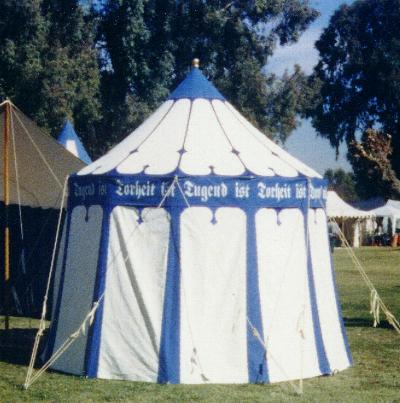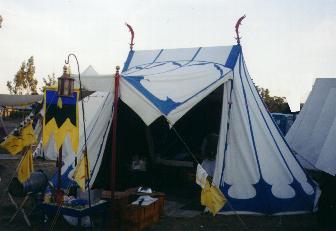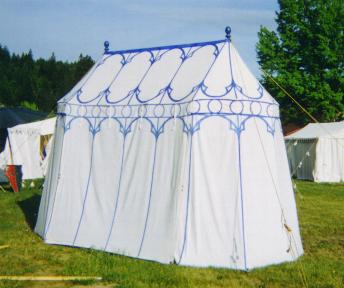

In a last month's column we displayed some period representations of painted tents, and discussed some of the motifs and styles used. This month's column shows a few of the snapshots I've taken of tents that particularly struck my eye as effective uses of paint to achieve a "period" look.
 I guess I'll just cast modesty to the winds and lead off with my own current tent, called "Torheit" (German for "silliness"). The design is actually a combination of colored fabric (the top cone, the valance, and the vertical blue components of the sidewall) and paint (the lines on the canopy and the decorated "points" and arch segments on the sidewall). If I were to do it over again, I'd make the arches more prominent by making the arch sections larger and tapering them toward the top. It's one of those things that looked a lot better on paper than it did on the finished tent. Otherwise, I'm satisfied with it. What doesn't show well on the picture is that the painted lines on the canopy flare into more arches at the top, giving the illusion that the cone is sitting on the twelve arches -- a demonstration of an architectural motif carried over to tent painting.
I guess I'll just cast modesty to the winds and lead off with my own current tent, called "Torheit" (German for "silliness"). The design is actually a combination of colored fabric (the top cone, the valance, and the vertical blue components of the sidewall) and paint (the lines on the canopy and the decorated "points" and arch segments on the sidewall). If I were to do it over again, I'd make the arches more prominent by making the arch sections larger and tapering them toward the top. It's one of those things that looked a lot better on paper than it did on the finished tent. Otherwise, I'm satisfied with it. What doesn't show well on the picture is that the painted lines on the canopy flare into more arches at the top, giving the illusion that the cone is sitting on the twelve arches -- a demonstration of an architectural motif carried over to tent painting.
 The next tent, painted by Heather Rose Jones (in the SCA, Baroness Tangwystyl verch Morgant Glasfryn), again demonstrates the architectural motif. Here the arches are actually painted in a sort of tromp d'oeil giving an illusion of solidity and depth. Note how the basic design of the sidewall panels is echoed on the canopy, with additional detail right at the ridge line that suggests that the design carries right over the top. You can also see how the pattern on the rear wall shows through as a backlit design. For my money, waking up to the sight of your design brilliantly brought to life against a canvas made glowing by the morning sun is one of the all-time great benefits of painting your tent.
The next tent, painted by Heather Rose Jones (in the SCA, Baroness Tangwystyl verch Morgant Glasfryn), again demonstrates the architectural motif. Here the arches are actually painted in a sort of tromp d'oeil giving an illusion of solidity and depth. Note how the basic design of the sidewall panels is echoed on the canopy, with additional detail right at the ridge line that suggests that the design carries right over the top. You can also see how the pattern on the rear wall shows through as a backlit design. For my money, waking up to the sight of your design brilliantly brought to life against a canvas made glowing by the morning sun is one of the all-time great benefits of painting your tent.
 the next tent, on the right, shows how effective you can be with just a little bit of paint. notice that there really isn't a lot of painting involved at all, and it looks like most of it was done using stencils. the brightly painted ridge line serves the purpose of drawing the eye upward, displaying the tent's height to best advantage. it appears that the vertical embellished panels might have been painted separately and then sewn onto the completed sidewall (or sewn between the side wall panels as they were seamed), thus simplifying the management of fabric as it's being painted. the use of caps on the side poles and "crow's feet" guy ropes enhance the period look of the tent.
the next tent, on the right, shows how effective you can be with just a little bit of paint. notice that there really isn't a lot of painting involved at all, and it looks like most of it was done using stencils. the brightly painted ridge line serves the purpose of drawing the eye upward, displaying the tent's height to best advantage. it appears that the vertical embellished panels might have been painted separately and then sewn onto the completed sidewall (or sewn between the side wall panels as they were seamed), thus simplifying the management of fabric as it's being painted. the use of caps on the side poles and "crow's feet" guy ropes enhance the period look of the tent.
 here, on the left, is another example of using a little paint to achieve a great effect. again, the actual amount of painting is small, and seems to be confined entirely to the canopy. you can see how the design starts just above the valance, with short lines that seem to support a second "valance line" (there's that architectural motif again) with further structures above that line. you can also see how the seam lines on the non-rounded part of the roof flare out to indicate "struts" that seem to support the painted ridge. This tent also has a form of crow's-nest guy rope arrangement, although the knot arrangement is partially concealed by the dags on the valance.
here, on the left, is another example of using a little paint to achieve a great effect. again, the actual amount of painting is small, and seems to be confined entirely to the canopy. you can see how the design starts just above the valance, with short lines that seem to support a second "valance line" (there's that architectural motif again) with further structures above that line. you can also see how the seam lines on the non-rounded part of the roof flare out to indicate "struts" that seem to support the painted ridge. This tent also has a form of crow's-nest guy rope arrangement, although the knot arrangement is partially concealed by the dags on the valance.

the last picture, on the right, shows a tent painted by andrew tye, known in the sca as master ivar hakonarson. he was the one who was extensively quoted in the column on "painting your tent" that we ran about two years ago. you can see how he has used his particular rendition of "architectural" design, particularly in his use of a solid base to form a defined bottom, middle, and top to the structure. (I feel obliged to add here that my own survey of period art failed to provide me with many examples of tents that used a painted base such as Master Ivar uses.) Also drawing the eye upward are the dolphin finials on the ends of the roof. I've also seen this tent with a ridge-piece of lattice-work extending from one finial to the other. There are also arches painted onto the flat side of the tent, just barely visible in this photo, in which the flat sides have been raised to form an awning.

 on the left is a picture from the stowe collection at the british museum, and on the right is a tent i made using the picture as inspiration. you'll notice that i didn't copy the tent in the foreground exactly, but borrowed a bit of detail from the roof of one of the tents in the background. the result is a tent that, i think, could have blended in easily with the rest of the tents in the picture, but was its own distinct design as well, and that was my aim. and if you really want your tent to enhance your medieval encampment, that should be your aim as well. it's ok to be a little creative, as long as you remain faithful to the time and place that inspired your creation. in other words, let it stand out from the crowd by virtue of its distinctiveness, not of its anachronisms. the highest praise i ever got for my painted tents was when somebody looked at it and said, "you know, i could swear i've seen that in some painting somewhere."
on the left is a picture from the stowe collection at the british museum, and on the right is a tent i made using the picture as inspiration. you'll notice that i didn't copy the tent in the foreground exactly, but borrowed a bit of detail from the roof of one of the tents in the background. the result is a tent that, i think, could have blended in easily with the rest of the tents in the picture, but was its own distinct design as well, and that was my aim. and if you really want your tent to enhance your medieval encampment, that should be your aim as well. it's ok to be a little creative, as long as you remain faithful to the time and place that inspired your creation. in other words, let it stand out from the crowd by virtue of its distinctiveness, not of its anachronisms. the highest praise i ever got for my painted tents was when somebody looked at it and said, "you know, i could swear i've seen that in some painting somewhere."